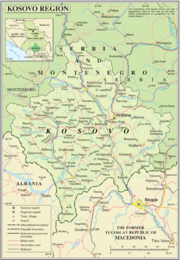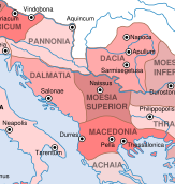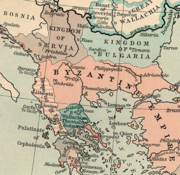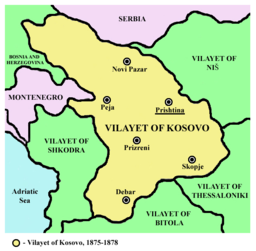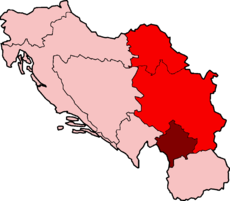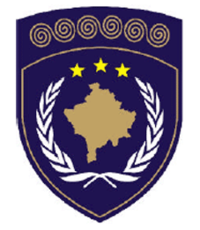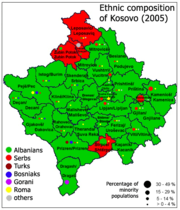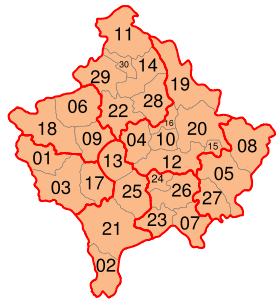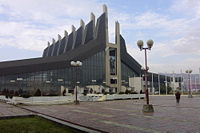Kosovo
2008/9 Schools Wikipedia Selection. Related subjects: Europe; European Countries
Template:Infobox Kosovo Kosovo ( Albanian: Kosova or Kosovë, Serbian: Косово и Метохија, Kosovo i Metohija; also Космет, Kosmet) is a province of Serbia which has been under United Nations administration since 1999. While Serbia's sovereignty is recognised by the international community, in practice Serbian governance in the province is virtually non-existent (see also Constitutional status of Kosovo). The province is governed by the United Nations Interim Administration Mission in Kosovo (UNMIK) with the help of the local Provisional Institutions of Self-Government (PISG), as well as security provided by the NATO-led Kosovo Force (KFOR).
Kosovo borders Montenegro, Albania, and the Republic of Macedonia. It has a population of just over two million people, predominantly ethnic Albanians, with smaller populations of Serbs, Turks, Bosniaks, Romani people, and other ethnic groups. Priština is the capital and largest city.
The province is the subject of a long-running political and territorial dispute between the Serbian (and previously, the Yugoslav) government and Kosovo's largely ethnic-Albanian population. International negotiations began in 2006 to determine the final status of Kosovo (See Kosovo status process).
Geography
With an area of 10,887 square kilometers (4,203 sq mi) and a population of nearly two million, Kosovo internationally borders Montenegro to the northwest, the Republic of Macedonia to the south, and Albania to the south west, while internally Central Serbia to the north and east.
The largest cities are Priština, the capital, with an estimated 600,000 inhabitants, Prizren in the south west with a population of 165,000, Peć in the west with 154,000, and Mitrovica in the north with 110,000. Five other towns have populations in excess of 97,000.
The climate in Kosovo is continental, with warm summers and cold and snowy winters.
There are two main plains in Kosovo. The Metohija basin is located in the western part of the Kosovo, and the Plain of Kosovo occupies the eastern part.
Much of Kosovo's terrain is rugged. The Šar Mountains are located in the south and south-east, bordering Macedonia. This is one of the region's most popular tourist and skiing resorts, with Brezovica and Prevalac as the main tourist centres. Kosovo's mountainous area, including the highest peak Đeravica, at 2656 m above sea level, is located in the south-west, bordering Albania and Montenegro.
The Kopaonik mountain is located in the north, bordering. The central region of Drenica, Carraleva and the eastern part of Kosovo, known as Golak, are mainly hilly areas.
There are several notable rivers and lakes in Kosovo. The main rivers are the White Drin, running towards the Adriatic Sea, with the Erenik among its tributaries), the Sitnica, the Morava in the Golak area, and Ibar in the north. The main lakes are Gazivoda (380 million m³) in the north-western part, Radonic (113 million m³) in the south-west part, Batlava (40 million m³) and Badovac (26 million m³) in the north-east part.
History
Classical Period
In ancient times, Kosovo was part of a bigger region called Dardania. It was inhabited by tribes postulated to be of mixed Thraco- Illyrian ethnicity which inhabited the Balkans since the late Bronze Age. The inhabitants were often at war with the Macedonians, and the southernmost part was directly incorporated into the growing Macedonian kingdom. With the rise of the Roman Empire, Augustus conquered the region in 28 BC, Kosovo came to lie within the Roman province of Moesia. The area was subject to a degree of Romanisation. When the Roman Empire split, the area subsequently fell under rule of the East Roman Empire (Byzantine Empire). The Byzantine empire continued its rule over the Balkans, albeit troubled by the successive raids of various nomadic hordes (Huns, Goths, Avars, Bulgars) - which were devastating to the area, resulting in depopulation of urban centers and loss of the wealth created by trade and mining.
Medieval Period
Arrival of the Slavs
By the 6th century, Slavic tribes from north and east of the Carpathian mountains began to settle the Balkans in successive waves. By 550s, they had settled most the Balkans including most of Greece. One of these Slavic migrants were the proto-Serbs. They settled a large area of the western Balkans, called Servia (Serbia) - which consisted of modern Serbia (including Kosovo), Montenegro and eastern parts of Bosnia and northern Macedonia. The Slavs actively assimilated many of the indigenous peoples of the Balkans. Some scattered tribes of Illyrians may have escaped the ethno-cultural assimilation, perhaps by fleeing to the mountainous regions of the western Balkans, even as early as during the Roman occupation.
Medieval Serbian state
The Slavic tribes, although nominally under Byzantine vassalage, essentially ruled themselves. With the need for a more effective defensive organization, zhupanates were formed (primitive principalities ruled by a Zhupan- a noble chieftain). The most powerful of these were those of Raska (modern central Serbia) and Dioclea (roughly what is now Montenegro), which grew to be powerful Balkan states in their own right, influencing other Serbian territories. By the 850s AD, Kosovo became part of the expanding Slavic Bulgarian Empire. During this time Slavic literacy and Christianity spread throughout the region. Bulgarian rule lasted until 1018, when the Byzantine Empire dealt a death blow to the last Bulgarian King, Tsar Samuil. In fact, the Byzantines re-asserted their rule over most of the Balkans for the first time since the 6th century.
A popular uprising against Byzantine rule commenced in Dioclea by Stefan Voislav. One Vukan, a nephew of the Dioclean King Mihailo (Voislav's descendent), was made Zhupan of Raska by his uncle. He struggled to free Raska from the Byzantines, and pushed through Kosovo c. 1092, and into Macedonia. There were several offensives and counter-offensives, however Vukan eventually accepted Byzantine vassalage. The full Serbian liberation of Kosovo from the Byzantines would not be achieved until 1208 by Stefan Nemanja of the Nemanjic dynasty. During this time Kosovo became the cultural, religious and political heart of the Serbian Kingdom. Numerous Christian monasteries were erected, such as the Visoki Dečani monastery. The zenith of medieval Serbia’s state was reached in 1346, when Stefan Dusan was crowned Emperor of Serbs, Vlachs, Greeks and Albanians, having conquered virtually all of Greece. However, with his death, his multiethnic Christian Empire also died due to internal power struggles, opening the Balkan’s up for the Ottoman invasion. The empire was split amongst regional nobility - Kosovo became a domain of the House of Mrnjavčević initially.
Historical sources suggest that medieval Kosovo had a Serbian character - Serbian was the cultural, political and linguistic idiom of the region. There are not many records delineating the ethnic composition of Kosovo, however, the earliest known census was the Decani charter in 1330. The vast majority of people are shown to be Slavic Serbian, however, there were also other ethnicities such as Vlachs, Bulgaro- Macedonians and Greeks. Less than 2% of households or farmsteads were Albanian. The Albanians are mentioned for the first time in the 11th century, in the Alexiad a medieval biographical text written around the year 1148 by the Byzantine historian Anna Comnena, daughter of Emperor Alexius I. There appears to be no records of any Albanian institutions or states in medieval Kosovo. This is not to say that Albanians, did not or had not been living in the area before this, but it merely re-affirms the notion that they were isolated from political power or influence and became a remote, shepherding people that dwelt in the rugged mountains of northern Albania.
Ottoman rule
The Ottomans invaded and met the Serbian Army under Prince Lazar on 28 June 1389, near Pristina, at Gazi Mestan. The Serbian Army was assisted by various allies. The epic Battle of Kosovo followed, in which Prince Lazar himself lost his life. Prince Lazar amassed 70,000 men on the battlefield and the Ottomans had 140,000. Through the cunning of Miloš Obilić, Sultan Murad was murdered and the new Sultan Beyazid had, despite winning the battle, to retreat to consolidate his power. The Ottoman Sultan was buried with one of his sons at Gazi Mestan. Both Prince Lazar and Miloš Obilić were canonized by the Serbian Orthodox Church for their efforts in the battle. The local House of Branković came to prominence as the local lords of Kosovo, under Vuk Branković, with the temporary fall of the Serbian Despotate in 1439. Another great battle occurred between the Hungarian troops supported by the Albanian ruler Gjergj Kastrioti Skanderbeg on one side, and Ottoman troops supported by the Brankovićs in 1448. Skanderbeg's troops that were going to help John Hunyadi were stopped by the Branković's troops, who was more or less a Turkish Vassal. Hungarian regent John Hunyadi lost the battle after a two-day fight, but essentially stopped the Ottoman advance northwards. Kosovo then became vassalaged to the Ottoman Empire, until its direct incorporation after the final fall of Serbia in 1459.
In 1455, new castles rose to prominence in Priština and Vučitrn, centres of the Ottoman vassalaged House of Branković.
Ottoman Empire
The Ottomans brought Islamisation with them, particularly in towns, and later also created the Vilayet of Kosovo as one of the Ottoman territorial entities. Kosovo was taken by the Austrian forces during the Great War of 1683– 1699 with help of 5,000 Albanians and their leader, a Catholic Archbishop Pjetër Bogdani. The archbishop died of plague during the war. In 1690, the Serbian Patriarch of Peć Arsenije III, who previously escaped a certain death, led 37,000 families from Kosovo, to evade Ottoman wrath since Kosovo had just been retaken by the Ottomans. The people that followed him were mostly Serbs and Albanians abandoned—but they were likely followed by other ethnic groups. Due to the oppression from the Ottomans, other migrations of Orthodox people from the Kosovo area continued throughout the 18th century. It is also noted that some Serbs adopted Islam, while some even gradually fused with other groups, predominantly Albanians, adopting their culture and even language.
In 1766, the Ottomans abolished the Patriarchate of Peć and the position of Christians in Kosovo was greatly reduced. All previous privileges were lost, and the Christian population had to suffer the full weight of the Empire's extensive and losing wars, even having blame forced upon them for the losses. The main reason for the conversion of Orthodox Albanians into Muslim Albanians was for the greater benefit of less taxes. Remnants of Orthodox Albanians, in Kosovo, went to live in mountains or rural parts of Montenegro.
Modern era
In 1871, a massive Serbian meeting was held in Prizren at which the possible retaking and reintegration of Kosovo and the rest of "Old Serbia" was discussed, as the Principality of Serbia itself had already made plans for expansions towards Ottoman territory.
Albanian refugees from the territories conquered in the 1876–1877 Serbo-Turkish war and the 1877–1878 Russo-Turkish war are now known as ' muhaxher' (which means 'refugee', from Arabic muhajir). Their descendants still have the same surname, Muhaxheri. It is estimated that 200,000 to 400,000 Serbs were cleansed out of the Vilayet of Kosovo between 1876 and 1912, especially during the Greek-Ottoman War in 1897.
In 1878, a Peace Accord was drawn that left the cities of Priština and Kosovska Mitrovica under civil Serbian control, and outside the jurisdiction of the Ottoman authorities, while the rest of Kosovo would be under Ottoman control. As a response, the Albanians formed the nationalistic and conservative League of Prizren in Prizren later the same year. Over three hundred Albanian leaders from Kosovo and western Macedonia gathered and discussed the urgent issues concerning protection of Albanian populated regions from division among neighbouring countries. The League was supported by the Ottoman Sultan because of its Pan-Islamic ideology and political aspirations of a unified Albanian people under the Ottoman umbrella. The movement gradually became anti-Christian and spread great anxiety among Christian Albanians and especially among Christian Serbs. As a result, more and more Serbs left Kosovo northwards. Serbia complained to the World Powers that the promised territories were not being held because the Ottomans were hesitating to do that. The World Powers put pressure on the Ottomans and in 1881, the Ottoman Army began fighting the Albanian forces. The Prizren League created a Provisional Government with a President, Prime Minister (Ymer Prizreni) and Ministries of War (Sylejman Vokshi) and Foreign Ministry (Abdyl Frashëri). After three years of war, the Albanians were defeated. Many of the leaders were executed and imprisoned. The subsequent Treaty of San Stefano in 1878 restored most Albanian lands to Ottoman control, but the Serbian forces had to retreat from Kosovo along with some Serbs that were expelled as well. By the end of the 19th century the Albanians replaced the Serbs as the dominant people in Kosovo.
In 1908, the Sultan brought a new democratic decree that was valid only for Turkish-speakers. As the vast majority of Kosovo spoke Albanian or Serbian, the Kosovar population was very unhappy. The Young Turk movement supported a centralist rule and opposed any sort of autonomy desired by Kosovars, and particularly the Albanians. In 1910, an Albanian uprising spread from Priština and lasted until the Ottoman Sultan's visit to Kosovo in June of 1911. The Aim of the League of Prizren was to unite the four Albanian Vilayets by merging the majority of Albanian inhabitants within the Ottoman Empire into one Albanian State. However, at that time Serbs have consisted about 25% of the whole Vilayet of Kosovo's overall population and were opposing the Albanian rule along with Turks and other Slavs in Kosovo, which disabled the Albanian movements to occupy Kosovo.
In 1912, during the Balkan Wars, most of Kosovo was taken by the Kingdom of Serbia, while the region of Metohija ( Albanian: Dukagjini Valley) was taken by the Kingdom of Montenegro. An exodus of the local Albanian population occurred. This is best described by Leon Trotsky, who was a reporter for the Pravda newspaper at the time. The Serbian authorities planned a recolonization of Kosovo. Numerous colonist Serb families moved-in to Kosovo, equalizing the demographic balance between Albanians and Serbs. Many Albanians fled into the mountains and numerous Albanian and Turkish houses were razed. The reconquest of Kosovo was noted as a vengeance for the 1389 Battle of Kossovo. At the Conference of Ambassadors in London in 1912 presided over by Sir Edward Grey, the British Foreign Secretary, the Kingdoms of Serbia and Montenegro were acknowledged sovereignty over Kosovo.
In the winter of 1915–1916, during World War I, Kosovo saw a large exodus of Serbian army which became known as the Great Serbian Retreat. Defeated and worn out in battles against Austro-Hungarians, they had no other choice than to retreat, as Kosovo was occupied by Bulgarians and Austro-Hungarians. The Albanians joined and supported the Central Powers. As opposed to Serbian schools, numerous Albanian schools were opened during the 'occupation' (the majority Albanian population considered it a liberation). Allied ships were awaiting for Serbian people and soldiers at the banks of the Adriatic sea and the path leading them there went across Kosovo and Albania. Tens of thousands of soldiers died of starvation, extreme weather and Albanian reprisals as they were approaching the Allies in Corfu and Thessaloniki, amassing a total of 100,000 dead retreaters. Transported away from the front lines, Serbian army managed to heal many wounded and ill soldiers and get some rest. Refreshed and regrouped, it decided to return to the battlefield. In 1918, the Serbian Army pushed the Central Powers out of Kosovo. During Serbian control of Kosovo, the Serbian Army committed atrocities against the population in revenge. Serbian Kosovo was unified with Montenegrin Metohija as Montenegro subsequently joined the Kingdom of Serbia. After the World War I ended, the Monarchy was then transformed into the Kingdom of Serbs, Croats and Slovenians (Serbo-Croatian: Kraljevina Srba, Hrvata i Slovenaca, Albanian: Mbretëria Serbe, Kroate, Sllovene) on 1 December 1918, gathering territories gained in victory.
Kingdom of Yugoslavia and World War II
The 1918–1929 period of the Kingdom of Serbs, Croats and Slovenians witnessed a raise of the Serbian population in the region and a decline in the non-Serbian. In the Kingdom Kosovo was split onto four counties—three being a part of the entity of Serbia: Zvečan, Kosovo and southern Metohija; and one of Montenegro: northern Metohija. However, the new administration system since 26 April 1922 split Kosovo among three Areas of the Kingdom: Kosovo, Rascia and Zeta. In 1921 the Albanian elite lodged an official protest of the government to the League of Nations, claiming that 12,000 Albanians had been killed and over 22,000 imprisoned since 1918 and seeking a unification of Albanian-populated lands. As a result, an armed Kachak resistance movement was formed whose main goal was to unite Albanian-populated areas of the Kingdom to Albania.
In 1929, the Kingdom was transformed into the Kingdom of Yugoslavia. The territories of Kosovo were split among the Banate of Zeta, the Banate of Morava and the Banate of Vardar. The Kingdom lasted until the World War II Axis invasion of 1941.
The greatest part of Kosovo became a part of Italian-controlled Fascist Albania, and smaller bits by the Tsardom of Bulgaria and Nazi German-occupied Kingdom of Serbia. During the fascist occupation of Kosovo by Albanians, until August 1941 alone, over 10,000 Serbs were killed and between 80,000 and 100,000 Serbs were expelled, while roughly the same number of Albanians from Albania were brought to settle in these Serbian lands.
Mustafa Kruja, the Prime Minister of Albania, was in Kosovo in June 1942, and at a meeting with the Albanian leaders of Kosovo, he said: "We should endeavor to ensure that the Serb population of Kosovo be – the area be cleansed of them and all Serbs who had been living there for centuries should be termed colonialists and sent to concentration camps in Albania. The Serb settlers should be killed."
Prior to the surrender of Fascist Italy in 1943, the German forces took over direct control of the region. After numerous uprisings of Partisans led by Fadil Hoxha, Kosovo was liberated after 1944 with the help of the Albanian partisans of the Comintern, and became a province of Serbia within the Democratic Federal Yugoslavia.
Kosovo in the second Yugoslavia
The province was first formed in 1945 as the Autonomous Kosovo-Metohian Area to protect its regional Albanian majority within the People's Republic of Serbia as a member of the Federal People's Republic of Yugoslavia under the leadership of the former Partisan leader, Josip Broz Tito, but with no factual autonomy. After Yugoslavia's name change to the Socialist Federal Republic of Yugoslavia and Serbia's to the Socialist Republic of Serbia in 1953, Kosovo gained inner autonomy in the 1960s. In the 1974 constitution, the Socialist Autonomous Province of Kosovo's government received higher powers, including the highest governmental titles — President and Prime Minister and a seat in the Federal Presidency which made it a de facto Socialist Republic within the Federation, but remaining as a Socialist Autonomous Province within the Socialist Republic of Serbia. Tito had pursued a policy of weakening Serbia, as he believed that a "Weak Serbia equals a strong Yugoslavia". To this end Vojvodina and Kosovo became autonomous regions and were given the above entitled privileges as de facto republics. Serbo-Croatian, Albanian and Turkish were defined as official languages on the provincial level marking the two largest linguistic Kosovan groups: Albanians and Serbs. In the 1970s, an Albanian nationalist movement pursued full recognition of the Province of Kosovo as another Republic within the Federation, while the most extreme elements aimed for full-scale independence. Tito's arbitrary regime dealt with the situation swiftly, but only giving it a temporary solution. The ethnic balance of Kosovo witnessed disproportional increase as the number of Albanians tripled gradually rising from almost 75% to over 90%, but the number of Serbs barely increased and dropped in the full share of the total population from some 15% down to 8%. Even though Kosovo was the least developed area of the former Yugoslavia, the living and economic prospects and freedoms were far greater than under the totalitarian Maoist regime in Albania.
Beginning in March 1981, Kosovar Albanian students organized protests seeking that Kosovo become a republic within Yugoslavia. Those protests rapidly escalated into violent riots "involving 20,000 people in six cities" that were harshly contained by the Yugoslav government. During the 1980s, ethnic tensions continued with frequent violent outbreaks against Serbs and Yugoslav state authorities resulting in increased emigration of Kosovo Serbs and other ethnic groups. The Yugoslav leadership tried to suppress protests of Kosovo Serbs seeking protection from ethnic discrimination and violence.
In 1986, the Serbian Academy of Sciences and Arts (SANU) was working on a document which later would be known as the SANU Memorandum, a warning to the Serbian President and Assembly of the existing crisis and where it would lead. An unfinished edition was filtered to the press. In the essay, SANU criticised the state of Yugoslavia and made remarks that the only member state contributing at the time to the development of Kosovo and Macedonia (by then, the poorest territories of the Federation) was Serbia. According to SANU, Yugoslavia was suffering from ethnic strife and the disintegration of the Yugoslav economy into separate economic sectors and territories, which was transforming the federal state into a loose confederation. On the other hand, some think that Slobodan Milošević used the discontent reflected in the SANU memorandum for his own political goals, during his rise to power in Serbia at the time.
Milošević was initially sent there as a member of the Communist party. Initially Milošević did not talk to the Serbian nationalists who were at that point demonstrating for rights and freedoms that had been denied to them. During these meetings he agreed to listen to their grievances. During the meeting, outside the building where this forum was taking place police started fighting the locals who had gathered there, mostly Serbs eager to voice their grievances. After hearing about the police brutality outside of the halls, Milošević came out and in an emotional moment promised the local Serbs that "No one is allowed to beat you." This newsbite was then seen on evening news and catapulted a then unknown Milošević to the forefront of the current debate about the problems on Kosovo.
In order to save his skin, Milošević fought back and established a political coup d'état. He gained effective leadership and control of the Serbian Communist party and pressed forward with the one issue that had catapulted him to the forefront of the political limelight, which was Kosovo. This By the end of the 1980s, calls for increased federal control in the crisis-torn autonomous province were getting louder. Slobodan Milošević pushed for constitutional change amounting to suspension of autonomy for both Kosovo and Vojvodina.
Kosovo and the breakup of Yugoslavia
Inter-ethnic tensions continued to worsen in Kosovo throughout the 1980s. In particular, Kosovo's ethnic Serb community, a minority of Kosovo population, complained about mistreatment from the Albanian majority. Miloševic capitalized on this discontent to consolidate his own position in Serbia. In 1987, Serbian President Ivan Stambolić sent Milošević to Kosovo to "pacify restive Serbs in Kosovo." On that trip, Milošević broke away from a meeting with ethnic Albanians to mingle with angry Serbians in a suburb of Pristina. As the Serbs protested they were being pushed back by police with batons, Milošević told them, "No one is allowed to beat you." This incident was later seen as pivotal to Milošević's rise to power.
On June 28, 1989, Milošević delivered a speech in front of a large number of Serb citizens at the main celebration marking the 600th anniversary of the Battle of Kosovo, held at Gazimestan. Many think that this speech helped Milošević consolidate his authority in Serbia.
In 1989, Milošević, employing a mix of intimidation and political maneuvering, drastically reduced Kosovo's special autonomous status within Serbia. Soon thereafter Kosovo Albanians organized a non-violent separatist movement, employing widespread civil disobedience, with the ultimate goal of achieving the independence of Kosovo. Kosovo Albanians boycotted state institutions and elections and established separate Albanian schools and political institutions. On July 2, 1990, an unconstitutional Kosovo parliament declared Kosovo an independent country, although this was not recognized by Belgrade or any foreign states. Two years later, in 1992, the parliament organized an unofficial referendum which was observed by international organizations but was not recognized internationally. With an 80% turnout, 98% voted for Kosovo to be independent.
Kosovo War
One of the events that contributed to Milošević's rise of power was the Gazimestan Speech, delivered in front of 100,000 Serb citizens at the central celebration marking the 600th anniversary of the Battle of Kosovo, held at Gazimestan on 28 June, 1989. Soon afterwards the autonomy of Kosovo was reduced. After Slovenia's secession from Yugoslavia in 1991, Milošević used the seat to attain dominance over the Federal government, outvoting his opponents.
Albanians organized a peaceful separatist movement. State institutions and elections were boycotted and separate Albanian schools and political institutions were established. On July 2, 1990 Kosovo Parliament declared Kosovo an independent country, this was only recognized by Albania. In September of that year, the parliament, meeting in secrecy in the town of Kaçanik, adopted the Constitution of the Republic of Kosovo. Two years later, in 1992, the parliament organized an unofficial referendum which was observed by international organizations but was not recognized internationally. With an 80% turnout, 98% voted for Kosovo to be independent.
With the events in Bosnia and Croatia coming to an end, the Serb government started relocating Serbian refugees from Croatia and Bosnia all over Serbia, including in Kosovo. In a number of cases, Albanian families were expelled from their apartments to make room for the refugees.
After the Dayton Agreement in 1995, some Albanians organized into the Kosovo Liberation Army (KLA), employing guerrilla-style tactics against Serbian police forces and civilians. Violence escalated in a series of KLA attacks and Serbian reprisals into the year 1999, with increasing numbers of civilian victims. In 1998 western interest increased and the Serbian authorities were forced to sign a unilateral cease-fire and partial retreat. Under an agreement devised by Richard Holbrooke, OSCE observers moved into Kosovo to monitor the ceasefire, while Yugoslav military forces partly pulled out of Kosovo. However, the ceasefire was systematically broken shortly thereafter by KLA forces, which again provoked harsh counterattacks by the Serbs. On 16 January 1999, the bodies of 45 Albanian civilians were found in the town of Racak. The victims had been executed by Serb forces. Independent forensic autopsies work on case Racak, team leader, Helena Ranta from Finland, say about Racak in "Berliner Zeitung", : Finnish pathologist Helena Ranta has expressed lack of comprehension regarding the work of the UN's Hague tribunal in the case of the so-called massacre of Racak. In an interview with "Berliner Zeitung", the head of the forensic team sent by the EU to investigate occurrences in the Kosovo village of Racak in January, 1999, criticized that indications of serious fighting between Serbian soldiers and Albanian fighters on the night of 15th to 16th of January, 1999, in the Racak area had been inadequately pursued. The so-called Racak Massacre was instrumental in increasing the pressure on Serbia in the following conference at Rambouillet. After more than a month of negotiations Yugoslavia refused to sign the prepared agreement, primarily, it has been argued, because of a clause giving NATO forces access rights to not only Kosovo but to all of Yugoslavia (which the Yugoslav side saw as tantamount to military occupation).
This triggered a 78-day NATO campaign in 1999. At first limited to military targets in Kosovo proper, the bombing campaign was soon extended to cover targets all over Yugoslavia, including bridges, power stations, factories, broadcasting stations, post offices, and various government buildings.
During the conflict roughly a million ethnic Albanians fled or were forcefully driven from Kosovo, several thousand were killed (the numbers and the ethnic distribution of the casualties are uncertain and highly disputed). An estimated 10,000-12,000 ethnic Albanians and 3,000 Serbs are believed to have been killed during the conflict. Some 3,000 people are still missing, of which 2,500 are Albanian, 400 Serbs and 100 Roma.
Some of the worst massacres against civilian Albanians occurred after that NATO started the bombing of Yugoslavia. Cuska massacre, Podujevo massacre , Velika Krusa massacre are some of the massacres committed by Serbian army, police and paramilitary.
During the Kosovo War, Serbs also engaged in a deliberate campaign of cultural destruction and rampage. According to a report compiled by the Kosovo Cultural Heritage Project, Serbian forces tried to wipe out all Albanian culture and traditions. Of the 500 mosques that were in use prior to the war, 200 of them were completely destroyed or desecrated. The report concludes that most mosques were deliberately set on fire with no sign of fighting around the area. Among numerous other things, the following important objects were destroyed because they represented Albanian as well as Muslim and Catholic cultures:
Sinan Pasha Mosque in Prizren, the Prizren League Museum, the Hadum Mosque complex in Gjakova (Serbian: Djakovica); the historic bazaars in Gjakova and Peć (Albanian: Peja); the Roman Catholic church of St. Anthony in Gjakova; and two old Ottoman bridges, Ura e Terzive (Terzijski most) and Ura e Tabakeve (Tabacki most), near Gjakova.
Also, several dozens of Serbian monasteries and churches were destroyed, burned or robbed by Albanians after NATO campaign by the end of 1999.
Kosovo after the war
After the war ended, the UN Security Council passed Resolution 1244 that placed Kosovo under transitional UN administration ( UNMIK) and authorized KFOR, a NATO-led peacekeeping force. Almost immediately, returning Kosovo Albanians attacked Kosovo Serbs , causing some 200,000-280,000 Serbs and other non-Albanians to flee (note: the current number of internally displaced persons is disputed, with estimates ranging from 65,000 to 250,000). Many displaced Serbs are afraid to return to their homes, even with UNMIK protection. Around 120,000-150,000 Serbs remain in Kosovo, but are subject to ongoing harassment and discrimination.
According to Amnesty International, the presence of peacekeepers in Kosovo led to an increase in the trafficking of women for sexual exploitation.
In 2001, UNMIK promulgated a Constitutional Framework for Kosovo that established the Provisional Institutions of Self-Government (PISG), including an elected Kosovo Assembly, Presidency and office of Prime Minister. Kosovo held its first free, Kosovo-wide elections in late 2001 (municipal elections had been held the previous year). UNMIK oversaw the establishment of a professional, multi-ethnic Kosovo Police Service.
In March 2004, Kosovo experienced its worst inter-ethnic violence since the Kosovo War. The unrest in 2004 was sparked by a series of minor events that soon cascaded into large-scale riots. Serbian men had unleashed their dogs on young Albanian boys, two of whom died. Protesting, the Kosovo Albanians mobs burned hundreds of Serbian houses, Serbian Orthodox Church sites (including some medieval churches and monasteries) and UN facilities. Kosovo Police established a special investigation team to handle cases related to the 2004 unrest and according to Kosovo Judicial Council by the end of 2006 the 326 charges filed by municipal and district prosecutors for criminal offenses in connection with the unrest had resulted in 200 indictments: convictions in 134 cases, and courts acquitted eight and dismissed 28; 30 cases were pending. International prosecutors and judges handled the most sensitive cases.
Kosovo Serbs working for the Serbian government receives since 1999 a stipend called kosovski dodatak. The extra payment was created during Miloševic regime, and it remains to this day.
Politics and governance
In 1999, UN Security Council Resolution 1244 placed Kosovo under transitional UN administration pending a determination of Kosovo's future status. This Resolution entrusted the United Nations Interim Administration Mission in Kosovo (UNMIK) with sweeping powers to govern Kosovo, but also directed UNMIK to establish interim institutions of self-governance. Resolution 1244 permits Serbia no role in governing Kosovo and since 1999 Serbian laws and institutions have not been valid in Kosovo. NATO has a separate mandate to provide for a safe and secure environment.
In May 2001, UNMIK promulgated the Constitutional Framework, which established Kosovo's Provisional Institutions of Self-Government (PISG). Since 2001, UNMIK has been gradually transferring increased governing competencies to the PISG, while reserving some powers that are normally carried out by sovereign states, such as foreign affairs. Kosovo has also established municipal government and an internationally-supervised Kosovo Police Service.
According to the Constitutional Framework, Kosovo shall have a 120-member Kosovo Assembly. The Assembly includes twenty reserved seats: ten for Kosovo Serbs and ten for non-Serb minorities (Bosniaks, Roma, etc.). The Kosovo Assembly is responsible for electing a President and Prime Minister of Kosovo.
The largest political party in Kosovo, the Democratic League of Kosovo (LDK), has its origins in the 1990s non-violent resistance movement to Miloševic's rule. The party was led by Ibrahim Rugova until his death in 2006. The two next largest parties have their roots in the Kosovo Liberation Army (KLA): the Democratic Party of Kosovo (PDK) led by former KLA leader Hashim Thaci and the Alliance for the Future of Kosovo (AAK) led by former KLA commander Ramush Haradinaj. Kosovo publisher Veton Surroi formed his own political party in 2004 named "Ora." Kosovo Serbs formed the Serb List for Kosovo and Metohija (SLKM) in 2004, but have boycotted Kosovo's institutions and never taken their seats in the Kosovo Assembly.
In November 2001, the OSCE supervised the first elections for the Kosovo Assembly. After that election, Kosovo's political parties formed an all-party unity coalition and elected Ibrahim Rugova as President and Bajram Rexhepi (PDK) as Prime Minister.
After Kosovo-wide elections in October 2004, the LDK and AAK formed a new governing coalition that did not include PDK and Ora. This coalition agreement resulted in Ramush Haradinaj (AAK) becoming Prime Minister, while Ibrahim Rugova retained the position of President. PDK and Ora were critical of the coalition agreement and have since frequently accused the current government of corruption.
Ramush Haradinaj resigned the post of Prime Minister after he was indicted for war crimes by the International Criminal Tribunal for the former Yugoslavia (ICTY) in March 2005. He was replaced by Bajram Kosumi (AAK). But in a political shake-up after the death of President Rugova in January 2006, Kosumi himself was replaced by former Kosovo Protection Corps commander Agim Ceku. Ceku has won recognition for his outreach to minorities, but Serbia has been critical of his wartime past as military leader of the KLA and claims he is still not doing enough for Kosovo Serbs. The Kosovo Assembly elected Fatmir Sejdiu, a former LDK parliamentarian, president after Rugova's death. Slaviša Petkovic, Minister for Communities and Returns, was previously the only ethnic Serb in the government, but resigned in November 2006 amid allegations that he misused ministry funds. Today two of the total thirteen ministries in Kosovo's Government have ministers from the minorities. Branislav Grbic, ethnic Serb, leads Minister of Returns and Sadik Idriz, ethnic Bosnjak, leads Ministry of Health
Parliamentary elections were held on 17 November 2007. After early results, Hashim Thaçi who was on course to gain 35 per cent of the vote, claimed victory for PDK, the Albanian Democratic Party, and stated his intention to declare independence. Thaci is likely to form a coalition with current President Fatmir Sejdiu's Democratic League which was in second place with 22 percent of the vote. The turnout at the election was particularly low with most Serbs refusing to vote.
Kosovo status process
International negotiations began in 2006 to determine the final status of Kosovo, as envisaged under UN Security Council Resolution 1244 which ended the Kosovo conflict of 1999. Whilst Serbia's continued sovereignty over Kosovo is recognised by the international community, a clear majority of the province's population would prefer independence.
The UN-backed talks, lead by UN Special Envoy Martti Ahtisaari, began in February 2006. Whilst progress was made on technical matters, both parties remained diametrically opposed on the question of status itself. In February 2007, Ahtisaari delivered a draft status settlement proposal to leaders in Belgrade and Pristina, the basis for a draft UN Security Council Resolution which proposes 'supervised independence' for the province. As of early July 2007 a draft resolution, backed by the United States, the United Kingdom and other European members of the Security Council, had been rewritten four times to try to accommodate Russian concerns that such a resolution would undermine the principle of state sovereignty. Russia, which holds a veto in the Security Council as one of five permanent members, had stated that it would not support any resolution which was not acceptable to both Belgrade and Kosovo Albanians. Whilst most observers had, at the beginning of the talks, anticipated independence as the most likely outcome, others have suggested that a rapid resolution might not be preferable.
After many weeks of discussions at the UN, the United States, United Kingdom and other European members of the Security Council formally 'discarded' a draft resolution backing Ahtisaari's proposal on 20 July 2007, having failed to secure Russian backing. Beginning in August, a " Troika" consisting of negotiators from the United States (Frank Wisner), the EU (Wolfgang Ischinger) and Russia (Alexander Botsan-Kharchenko) launched a new effort to reach a status outcome acceptable to both Belgrade and Pristina. Despite Russian disapproval, the U.S., Britain, and France appear likely to recognize Kosovar independence if it is declared after December 10, 2007, the date upon which the Contact Group will report on the Troika's efforts to UN Secretary General Ban Ki-moon.
Now that the mandate of the " Troika" is over ,Independence is thought to be declared by the Kosovans either in Februrary or in the early spring.
Health
Access to health care is free for all residents of Kosovo. Currently there is no health insurance, however, the Ministry of Health is in the process of preparing a legislative infrastructure, which is scheduled to be implemented in 2008.
There are hospitals in all major cities. A total of 6 regional hospitals provide tertiary health care, and family centers in small municipalities.
Medical Education is available at the University Clinical Centre of Kosovo (UCCK), in Priština.
Economy
Kosovo has one of the most under-developed economies in Europe, with a per capita income estimated at €1,565 (2004). Despite substantial development subsidies from all Yugoslav republics, Kosovo was the poorest province of Yugoslavia. Additionally, over the course of the 1990s a blend of poor economic policies, international sanctions, poor external commerce and ethnic conflict severely damaged the economy.
Kosovo's economy remains weak. After a jump in 2000 and 2001, growth in Gross Domestic Product (GDP) was negative in 2002 and 2003 and is expected to be around 3 percent 2004-2005, with domestic sources of growth unable to compensate for the declining foreign assistance. Inflation is low, while the budget posted a deficit for the first time in 2004. Kosovo has high external deficits. In 2004, the deficit of the balance of goods and services was close to 70 percent of GDP. Remittances from Kosovars living abroad accounts for an estimated 13 percent of GDP, and foreign assistance for around 34 percent of GDP.
Most economic development since 1999 has taken place in the trade, retail and the construction sectors. The private sector that has emerged since 1999 is mainly small-scale. The industrial sector remains weak and the electric power supply remains unreliable, acting as a key constraint. Unemployment remains pervasive, at around 40-50% of the labor force.
UNMIK introduced de-facto an external trade regime and customs administration on September 3, 1999 when it set customs border controls in Kosovo. All goods imported in Kosovo face a flat 10% customs duty fee. These taxes are collected from all Tax Collection Points installed at the borders of Kosovo, including those between Kosovo and Serbia. UNMIK and Kosovo institutions have signed Free Trade Agreements with Croatia, Bosnia and Herzegovina, Albania and Macedonia.
The Republic of Macedonia is Kosovo's largest import and export market (averaging €220 million and €9 million, respectively), followed by Serbia-Montenegro (€111 million and €5 million), Germany and Turkey.
The Euro is the official currency of Kosovo and used by UNMIK and the government bodies. The Serbian Dinar is used in the Serbian populated parts.
The economy is hindered by Kosovo's still-unresolved international status, which has made it difficult to attract investment and loans. The province's economic weakness has produced a thriving black economy in which smuggled petrol, cigarettes and cement are major commodities. The prevalence of official corruption and the pervasive influence of organised crime gangs has caused serious concern internationally. The United Nations has made the fight against corruption and organised crime a high priority, pledging a "zero tolerance" approach.
Demographics
According to the Kosovo in Figures 2005 Survey of the Statistical Office of Kosovo, Kosovo's total population is estimated between 1.9 and 2.2 million in the following ethnic proportions (but many pre-1999 Kosovar Serbs and individuals from other ethnic groups originally from Kosovo now live in Central Serbia, about 250.000-350.000). The estimate from 2000-2002-2003 goes (a 1,900,000 strong population):
- 92% Albanians
- 4% Serbs
- 2% Bosniaks and Gorans
- 1% Roma
- 1% Turks
Sunni Muslims account for more than 90% of the population in Kosovo Catholicism and Orthodoxy are also practiced by the people.
Ethnic Albanians in Kosovo have the largest population growth in Europe. The people’s growth rate in Kosovo is 1.3%. Over an 82-year period (1921-2003) the population grew 4.6 times. If growth continues at such a pace, based on some estimations, the population will be 4.5 million by 2050.
Administrative divisions
Districts
Kosovo is divided into seven districts:
- Đakovica/Gjakova District
- Gnjilane/Gjilani District
- Kosovska Mitrovica/Mitrovica District
- Peć/Peja District
- Priština/Prishtina District
- Prizren/Prizreni District
- Uroševac/Ferizaji District
North Kosovo maintains its own government, infrastructure and institutions by its dominant ethnic Serb population in the Mitrovica District, viz. in the Leposavic, Zvecan and Zubin Potok municipalities and the northern part of Kosovska Mitrovica.
Municipalities
Kosovo is also divided into 30 municipalities :
Cities
List of largest cities in Kosovo (with population figures for 2006):
- Priština : 571,532
- Prizren : 165,229
- Uroševac : 197,741
- Đakovica : 127,156
- Peć : 195,190
- Gnjilane : 191,595
- Kosovska Mitrovica : 186,359
- Podujevo : 48,526
Culture
Music
Although in Kosovo the music is diverse (influenced to an extent by the cultures of the various regimes who controlled the region), authentic Albanian music (see World Music) and Serbian music do still exist. Albanian music is characterized by the use of the çiftelia (an authentic Albanian instrument), mandolin, mandola and percussion. In Kosovo, folk music is very popular alongside modern music. There are a number of folk singers and ensembles (both Albanian and Serbian). Classical music is also well known in Kosovo and has been taught at universities (at the University of Priština Faculty of Arts and the University of Priština at Kosovska Mitrovica Faculty of Arts) and several pre- college music schools
There are some notable music festivals in Kosovo:
- Rock për Rock - contains rock and metal music
- Polifest - contains all kinds of genres (usually hip hop, commercial pop, unusually rock and never metal)
- Showfest - contains all kinds of genres (usually hip hop, commercial pop, unusually rock and never metal)
- Videofest - contains all kinds of genres
- Kush Këndon Lutet Dy Herë - contains christian music
- North City Jazz & Blues festival, an international music festival held annually in Zvečan ( Albanian: Zveçani), near Kosovska Mitrovica,
Kosovo Radiotelevisions like RTK, 21 and KTV have their musical charts.
